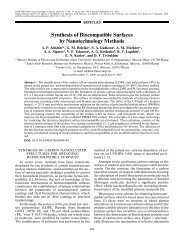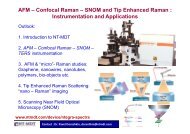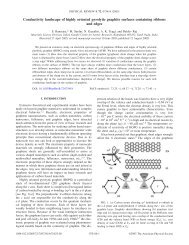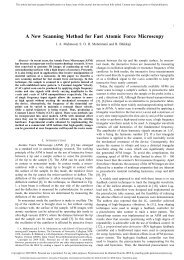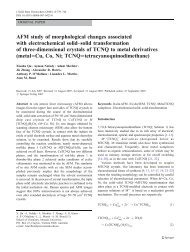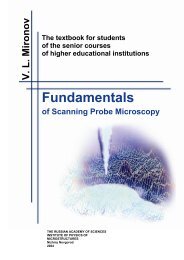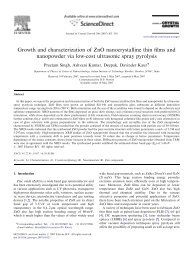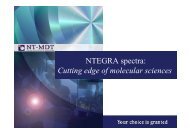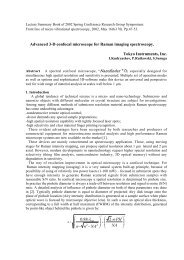Observation and control of blinking nitrogen-vacancy centres in ...
Observation and control of blinking nitrogen-vacancy centres in ...
Observation and control of blinking nitrogen-vacancy centres in ...
Create successful ePaper yourself
Turn your PDF publications into a flip-book with our unique Google optimized e-Paper software.
NATURE NANOTECHNOLOGY DOI: 10.1038/NNANO.2010.56LETTERSmolecular weight PVAs were used: average M w , 85,000–24,000 (Aldrich 363146);average M w , 31,000–50,000 (Aldrich 363138).The agglomerated nanodiamonds were measured us<strong>in</strong>g optical microscopy <strong>and</strong>AFM-zoom<strong>in</strong>g on the regions <strong>of</strong> clear aggregation. Simultaneous topographic <strong>and</strong>lum<strong>in</strong>escence imag<strong>in</strong>g <strong>of</strong> the same sample area was carried out us<strong>in</strong>g a ‘home-built’,room-temperature confocal scann<strong>in</strong>g fluorescence microscope (×100 oil-immersionobjective lens, NA 1.4) illum<strong>in</strong>ated with a cont<strong>in</strong>uous-wave 532-nm diode-pumpedsolid-state laser (Coherent, model: Compass 315M-100), comb<strong>in</strong>ed with acommercial AFM (NT-MDT Ntegra) as described elsewhere 11 . The lum<strong>in</strong>escencespectrum was acquired us<strong>in</strong>g a spectrometer (Pr<strong>in</strong>ceton Instruments Acton 2500i,Camera Pixis 100 model: 7515-0001). A Hanbury Brown <strong>and</strong> Twiss <strong>in</strong>terferometerwas used to measure the second-order correlation function g (2) (t) ¼ ,I(t)I(t þ t)/I(t) 2 . , where I is the lum<strong>in</strong>escence signal <strong>in</strong>tensity. The number <strong>of</strong> emittersper <strong>in</strong>dividual illum<strong>in</strong>ated nanocrystal was determ<strong>in</strong>ed by analys<strong>in</strong>g g (2) at t ¼ 0 <strong>and</strong>t ¼ 1, where g (2) (t ¼ 0) is the probability <strong>of</strong> detect<strong>in</strong>g two simultaneous photonsnormalized by the probability <strong>of</strong> detect<strong>in</strong>g two photons at once for a r<strong>and</strong>om photonsource. Because a s<strong>in</strong>gle quantum system, such as a s<strong>in</strong>gle NV centre, cannotsimultaneously emit two photons at a time, g (2) (t ¼ 0) ¼ 0, yield<strong>in</strong>g an‘antibunch<strong>in</strong>g’ dip otherwise governed by the sub-Poissonian statistics <strong>of</strong> the emittedphotons. The g (2) -contrast reports on the number <strong>of</strong> sampled emitters N e , because itscales as 1/ N e (ref. 1).ODMR <strong>in</strong>terrogation <strong>of</strong> the s<strong>in</strong>gle NV <strong>centres</strong> was designed <strong>and</strong> carried outus<strong>in</strong>g the accepted quantum-mechanical representation <strong>of</strong> an NV centre. The centrerepresents a two-level quantum system, which can be pumped to the first allowedenergy level (excited state) by 532-nm laser excitation. The NV triplet ground energylevels with magnetic quantum numbers m s ¼ 0 <strong>and</strong> m s ¼+1 are split by sp<strong>in</strong>–sp<strong>in</strong><strong>in</strong>teraction by ≏2.88 GHz. The cyclic lum<strong>in</strong>escence <strong>of</strong> the m s ¼+1 excited state is 30%less efficient than that <strong>of</strong> the m s ¼ 0 excited state. The optical pump<strong>in</strong>g populates them s ¼ 0 ground state, thereby sp<strong>in</strong>-polariz<strong>in</strong>g the NV centre. Microwave radiation(2.88 GHz) mixes two ground states, thus caus<strong>in</strong>g a decrease <strong>in</strong> the lum<strong>in</strong>escencesignal, which represents an unambiguous f<strong>in</strong>gerpr<strong>in</strong>t for the NV centre 33 .Themicrowave probe signal (0.2–0.6 mW) from a signal generator (Rohde & SchwarzSMIQ 06B, 300 kHz to 6.4 GHz) was radiated through a 20-mm copper wire situatedon the sample substrate <strong>in</strong> sub-millimetre proximity to the probed NV centre. Theobserved ODMR spectrum featured two peaks, <strong>in</strong>dicat<strong>in</strong>g lift<strong>in</strong>g <strong>of</strong> the m s ¼+1degeneracy, which was recognized to be stra<strong>in</strong>-<strong>in</strong>duced <strong>in</strong> nanodiamonds 6 .Theoretical simulations were performed us<strong>in</strong>g the density-functional-basedtight-b<strong>in</strong>d<strong>in</strong>g method with self-consistent charges (SCC-DFTB) 34 , which is a twocentreapproach to density functional theory, where the Kohn–Sham densityfunctional is exp<strong>and</strong>ed to second order around a reference electron density. Thereference density was obta<strong>in</strong>ed from self-consistent density functional calculations<strong>of</strong> weakly conf<strong>in</strong>ed neutral atoms, <strong>and</strong> the conf<strong>in</strong>ement potential was optimized toanticipate the charge density <strong>and</strong> effective potential <strong>in</strong> molecules <strong>and</strong> solids. Thismethod has the advantage <strong>of</strong> be<strong>in</strong>g non-periodic, <strong>and</strong> has previously been shown tobe suitable for study<strong>in</strong>g the crystall<strong>in</strong>ity <strong>of</strong> diamond nanoparticles 35 <strong>and</strong> thedistribution <strong>of</strong> substitutional <strong>nitrogen</strong> 7 . In the present study, all test structures werefully relaxed us<strong>in</strong>g the conjugate gradient scheme to m<strong>in</strong>imize the total energy. Theconvergence criterion for a stationary po<strong>in</strong>t was 10 24 a.u. ≈5 meV Å 21 for forces.Received 15 January 2010; accepted 1 March 2010;published onl<strong>in</strong>e 11 April 2010References1. Kurtsiefer, C., Mayer, S., Zarda, P. & We<strong>in</strong>furter, H. Stable solid-state source <strong>of</strong>s<strong>in</strong>gle photons. Phys. Rev. Lett. 85, 290–293 (2000).2. Balasubramanian, G. et al. Nanoscale imag<strong>in</strong>g magnetometry with diamondsp<strong>in</strong>s under ambient conditions. Nature 455, 648–651 (2008).3. Maze, J. R. et al. Nanoscale magnetic sens<strong>in</strong>g with an <strong>in</strong>dividual electronic sp<strong>in</strong><strong>in</strong> diamond. Nature 455, 644–647 (2008).4. Chang, Y.-R. et al. Mass production <strong>and</strong> dynamic imag<strong>in</strong>g <strong>of</strong> fluorescentnanodiamonds. Nature Nanotech. 3, 284–288 (2008).5. Smith, B. R. et al. Five-nanometer diamond with lum<strong>in</strong>escent <strong>nitrogen</strong>-<strong>vacancy</strong>defect centers. Small 5, 1649–1653 (2009).6. Tisler, J. et al. Fluorescence <strong>and</strong> sp<strong>in</strong> properties <strong>of</strong> defects <strong>in</strong> s<strong>in</strong>gle digitnanodiamonds. ACS Nano 3, 1959–1965 (2009).7. Barnard, A. S. & Sternberg, M. Substitutional <strong>nitrogen</strong> <strong>in</strong> nanodiamond <strong>and</strong>bucky-diamond particles. J. Phys. Chem. B 109, 17107–17112 (2005).8. Kruger, A. et al. Unusually tight aggregation <strong>in</strong> detonation nanodiamond:identification <strong>and</strong> dis<strong>in</strong>tegration. Carbon 43, 1722–1730 (2005).9. Mochal<strong>in</strong>, V. N. & Gogotsi, Y. Wet chemistry route to hydrophobic bluefluorescent nanodiamond. J. Am. Chem. Soc. 131, 4594–4595 (2009).10. Holt, K. B. Diamond at the nanoscale: applications <strong>of</strong> diamond nanoparticlesfrom cellular biomarkers to quantum comput<strong>in</strong>g. Phil. Trans. R. Soc. A 365,2845–2861 (2007).11. Bradac, C., Gaebel, T., Naidoo, N., Rabeau, J. R. & Barnard, A. S. Prediction <strong>and</strong>measurement <strong>of</strong> the size-dependent stability <strong>of</strong> fluorescence <strong>in</strong> diamond over theentire nanoscale. Nano Lett. 9, 3555–3564 (2009).12. Rabeau, J. R. et al. S<strong>in</strong>gle <strong>nitrogen</strong> <strong>vacancy</strong> centers <strong>in</strong> chemical vapor depositeddiamond nanocrystals. Nano Lett. 7, 3433–3437 (2007).13. Vlasov, I. et al. Nitrogen <strong>and</strong> lum<strong>in</strong>secent <strong>nitrogen</strong>-<strong>vacancy</strong> defects <strong>in</strong>detonation nanodiamond. Small 6, 687–694 (2010).14. Boudou, J. P. et al. High yield fabrication <strong>of</strong> fluorescent nanodiamonds.Nanotechnology 20, 235602 (2009).15. Smith, B. R., Gruber, D. & Plakhotnik, T. The effects <strong>of</strong> surface oxidation onlum<strong>in</strong>escence <strong>of</strong> nano diamonds. Diamond Relat. Mater. 19, 314–318 (2010).16. Gaebel, T. et al. Photochromism <strong>in</strong> s<strong>in</strong>gle <strong>nitrogen</strong>-<strong>vacancy</strong> defect <strong>in</strong> diamond.Appl. Phys. B 82, 243–246 (2006).17. Kuno, M., Fromm, D. P., Hamann, H. F., Gallagher, A. & Nesbitt, D. J. ‘On’/‘<strong>of</strong>f’fluorescence <strong>in</strong>termittency <strong>of</strong> s<strong>in</strong>gle semiconductor quantum dots. J. Chem.Phys. 115, 1028–1040 (2001).18. Tang, J. & Marcus, R. A. Diffusion-<strong>control</strong>led electron transfer processes <strong>and</strong>power-law statistics <strong>of</strong> fluorescence <strong>in</strong>termittency <strong>of</strong> nanoparticles. Phys. Rev.Lett. 95, 107401 (2005).19. Stefani, F. D., Hoogenboom, J. P. & Barkai, E. Beyond quantum jumps: <strong>bl<strong>in</strong>k<strong>in</strong>g</strong>nanoscale light emitters. Phys. Today 34–39 (February 2009).20. Nirmal, M. et al. Fluorescence <strong>in</strong>termittency <strong>in</strong> s<strong>in</strong>gle cadmium selenidenanocrystals. Nature 383, 802–804 (1996).21. Hoogenboom, J. P., van Dijk, E., Hern<strong>and</strong>o, J., van Hulst, N. F. & Garcia-Parajo, M. F. Power-law-distributed dark states are the ma<strong>in</strong> pathway forphotobleach<strong>in</strong>g <strong>of</strong> s<strong>in</strong>gle organic molecules. Phys. Rev. Lett. 95, 097401 (2005).22. Mason, M. D., Credo, G. M., Weston, K. D. & Buratto, S. K. Lum<strong>in</strong>escence <strong>of</strong><strong>in</strong>dividual porous Si chromophores. Phys. Rev. Lett. 80, 5405–5408 (1998).23. Cichos, F., von Borczyskowski, C. & Orrit, M. Power-law <strong>in</strong>termittency <strong>of</strong> s<strong>in</strong>gleemitters. Curr. Op<strong>in</strong>. Colloid Interface Sci. 12, 272–284 (2007).24. Frantsuzov, P., Kuno, M., Janko, B. & Marcus, R. A. Universal emission<strong>in</strong>termittency <strong>in</strong> quantum dots, nanorods <strong>and</strong> nanowires. Nature Phys. 4,519–522 (2008).25. Gomez, D. E., van Embden, J., Mulvaney, P., Fernee, M. J. & Rub<strong>in</strong>szte<strong>in</strong>-Dunlop, H. Exciton–trion transitions <strong>in</strong> s<strong>in</strong>gle CdSe–CdS core–shellnanocrystals. ACS Nano 3, 2281–2287 (2009).26. Zhang, K., Chang, H. Y., Fu, A. H., Alivisatos, A. P. & Yang, H. Cont<strong>in</strong>uousdistribution <strong>of</strong> emission states from s<strong>in</strong>gle CdSe/ZnS quantum dots. Nano Lett.6, 843–847 (2006).27. Palosz, B. et al. Investigation <strong>of</strong> relaxation <strong>of</strong> nanodiamond surface <strong>in</strong> real <strong>and</strong>reciprocal spaces. Diamond Relat. Mater. 15, 1813–1817 (2006).28. Osswald, S., Yush<strong>in</strong>, G., Mochal<strong>in</strong>, V., Kucheyev, S. O. & Gogotsi, Y. Control <strong>of</strong>sp (2) /sp (3) carbon ratio <strong>and</strong> surface chemistry <strong>of</strong> nanodiamond powders byselective oxidation <strong>in</strong> air. J. Am. Chem. Soc. 128, 11635–11642 (2006).29. Iakoubovskii, K. et al. Structure <strong>and</strong> defects <strong>of</strong> detonation synthesisnanodiamond. Diamond Relat. Mater. 9, 861–865 (2000).30. Russo, S. P., Barnard, A. S. & Snook, I. K. Hydrogenation <strong>of</strong> nanodiamondsurfaces: structure <strong>and</strong> effects on crystall<strong>in</strong>e stability. Surf. Rev. Lett. 10,233–239 (2003).31. Morita, Y. et al. A facile <strong>and</strong> scalable process for size-<strong>control</strong>lable separation <strong>of</strong>nanodiamond particles as small as 4 nm. Small 4, 2154–2157 (2008).32. Ushizawa, K. et al. Covalent immobilization <strong>of</strong> DNA on diamond <strong>and</strong> itsverification by diffuse reflectance <strong>in</strong>frared spectroscopy. Chem. Phys. Lett. 351,105–108 (2002).33. Gruber, A. et al. Scann<strong>in</strong>g confocal optical microscopy <strong>and</strong> magnetic resonanceon s<strong>in</strong>gle defect centers. Science 276, 2012–2014 (1997).34. Porezag, D., Frauenheim, T., Kohler, T., Seifert, G. & Kaschner, R. Construction<strong>of</strong> tight-b<strong>in</strong>d<strong>in</strong>g-like potentials on the basis <strong>of</strong> density-functional theory—application to carbon. Phys. Rev. B 51, 12947–12957 (1995).35. Barnard, A. S. & Sternberg, M. Crystall<strong>in</strong>ity <strong>and</strong> surface electrostatics <strong>of</strong>diamond nanocrystals. J. Mater. Chem. 17, 4811–4819 (2007).AcknowledgementsThe authors would like to thank N. Manson <strong>and</strong> F. Treussart for useful discussions, D. Birchfor TEM measurements <strong>and</strong> E. Carter for Raman spectroscopy measurements. T.G. isfunded by a Macquarie University Research Fellowship, C.B. is funded by a MacquarieUniversity Research Excellence Scholarship, <strong>and</strong> J.R.R is funded by an ARC FutureFellowship. The work was funded <strong>in</strong> part by the Australian Research Council (DP0772286<strong>and</strong> DP0771676).Author contributionsC.B., T.G., A.V.Z. <strong>and</strong> J.R.R. conceived <strong>and</strong> designed the experiments, analysed the data,contributed materials/analysis tools <strong>and</strong> co-wrote the paper. T.P. analysed the data <strong>and</strong>contributed analysis tools. M.J.S. contributed ESR equipment <strong>and</strong> expertise. A.S.B. carriedout DFTB simulations <strong>and</strong> analysed simulation data. N.N., J.T., L.B. <strong>and</strong> J.R.R. designed thedeaggregation protocol. N.N. prepared the nanodiamond samples. All authors discussedthe results <strong>and</strong> commented on the manuscript.Additional <strong>in</strong>formationThe authors declare no compet<strong>in</strong>g f<strong>in</strong>ancial <strong>in</strong>terests. Supplementary <strong>in</strong>formationaccompanies this paper at www.nature.com/naturenanotechnology. Repr<strong>in</strong>ts <strong>and</strong>permission <strong>in</strong>formation is available onl<strong>in</strong>e at http://npg.nature.com/repr<strong>in</strong>ts<strong>and</strong>permissions/.Correspondence <strong>and</strong> requests for materials should be addressed to A.V.Z. or J.R.R.NATURE NANOTECHNOLOGY | ADVANCE ONLINE PUBLICATION | www.nature.com/naturenanotechnology 5© 2010 Macmillan Publishers Limited. All rights reserved.



